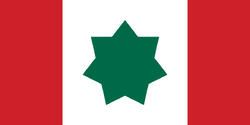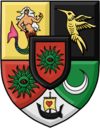Valtirians
 Flag of Sabia and Verona | ||||||||||||
| Total population | ||||||||||||
|---|---|---|---|---|---|---|---|---|---|---|---|---|
| 132a | ||||||||||||
| Regions with significant populations | ||||||||||||
| ||||||||||||
| Languages | ||||||||||||
|
Predominantly Sabian and Spanish | ||||||||||||
| Religion | ||||||||||||
|
Predominantly Pahunism, Christianity and irreligiousness |
Valtirians (Spanish: valtiries,[1] Sabian: valtirgenn, Lycene: valtiriqar), also known as Sabioveronese people are a people group associated and identified with the country of Sabia and Verona (Valtiria), a micronation based in South America. These may be residents of Sabioveronese territories (which are enclaved by Argentina and Venezuela[2][3]), individuals who hold Sabioveronese citizenship, or any person who has a historic or cultural relationship with Sabia and Verona.
Sabia and Verona was founded in 2012 as an overseas territory of Juclandia, a Romania-based micronation. Since 2016, Sabia and Verona has self-identified as a fully independent state, but the two nations are still close culturally, historically and politically. Sabia and Verona shares Juclandia's cultural trait of recognizing plush toys (stuffed toys, cuddly toys, plushies, etc.) as citizens, with complete sentience and legal rights; this cultural trait is enshrined in the country's constitution.[4] A majority of Valtirians (88.63%) are in fact plush toys; the remaining minority (11.36%) are humans.
The word Valtirian comes from the name of the geographical and cultural area in which Sabia and Verona was founded, the Valtir. The Valtir (also known in micronational historiography as the Valtir sector) is located in Western Venezuela.
Sub-groups

Valtirians are usually divided into a number of sub-groups, mostly based on geographical boundaries, but also by species and national background; these are the source of Valtirians' complex intersectional identities. Most Valtirians who identify with a regional sub-group are plush toys, while human Valtirians are more likely to adopt the umbrella term Valtirian as their sole national or co-national identity.
Nowadays, the lines that divide the sub-groups are increasingly blurred. A collective identification with the term "Valtirian", instead of with specific regional identities, is reportedly on the rise. Cultural exchange between the Sabioveronese regions and between the two Sabioveronese territories has effectively made it impossible to identify an unpolluted sub-group identity.
By species
The most common subdivision of the Valtirian people is by species: humans and plush toys (vali and buni). The recognition of plush toys as sentient citizens, with personalities, personal motivations and desires, and rights, is part of the Juclandian tradition that arrived to the Valtir sector with the formation of Sabia and Verona. According to government figures, plush toys make up over 80% of the population of Sabia and Verona.
Human citizens are a vocal minority. Despite never having comprised more than 15% of the population since the Kingdom's foundation, humans have controlled the higher strata of the political and economic system of Sabia and Verona. By constitutional ordenance, the King of the Valtirians must always be a human, though plush toys are allowed to participate in royal elections alongside humans.
By region

Sabians (sabini) compose account for a plurality of Valtirians. They are native to the region of Sabia, the most populated of the Sabioveronese regions and, before 2015, the most influential region in terms of politics, economy and culture. The sole official and national language of Sabia and Verona, Sabian, was developed as a conlang in Sabia. Sabians have traditionally dominated Valtirian politics, and Sabian nationalism (also called "Pan-Sabianism") was a major element of Sabioveronese politics from 2013 to 2015, expressed in groups like the Righteous Faith League and the Unity Party under Bertrand Rivière. Since the execution of the Haronos Plan in 2015 brought forth new territories into the fold and moved the administrative and economic centers of the Kingdom to Alios and the Southern territories, the importance of Sabia has significantly diminished in Sabia and Verona.
Many natives of Verona identify as Pashqaris. The Pashqaris surged in 2013 in response to the rise of Sabian nationalism; early on they counted with their own distinct culture, which included a language a creed of Pahunism (Fäkhism) and literary expressions such as poetry and music. Between 2013 and 2015, Pashqaris sought to be recognized as a nation within Sabia and Verona and became organized into political movements that pursued Pashqari-only interests; the most recognizable and known of these was the Pashqari People's Party. The Pashqari identity declined in early 2015 with the "Sabianization" policies adopted by the national conservative government of Bertrand Rivière, who sought to unify the Valtirian territories under a Sabian-only identity. The Pashqar language is now considered defunct, and Pashqaris have, for the most part, integrated into the amalgamated Valtirian society.
References
- ↑ "Amendment proposal gets parliamentary approval". The SiV Phonograph. 23 December 2019. Retrieved 17 May 2020.
- ↑ "The eternal laurels, the peculiar Exodus and the Braganza way" The SiV Phonograph. 14 August 2015. Retrieved 11 January 2018.
- ↑ "Alcabala sees the tricolour flag rising" The SiV Phonograph. 20 October 2012. Retrieved 11 January 2018.
- ↑ "Why stuffed toys?" Government of Sabia and Verona (sivgov.wixsite.com). Retrieved 17 May 2020.
